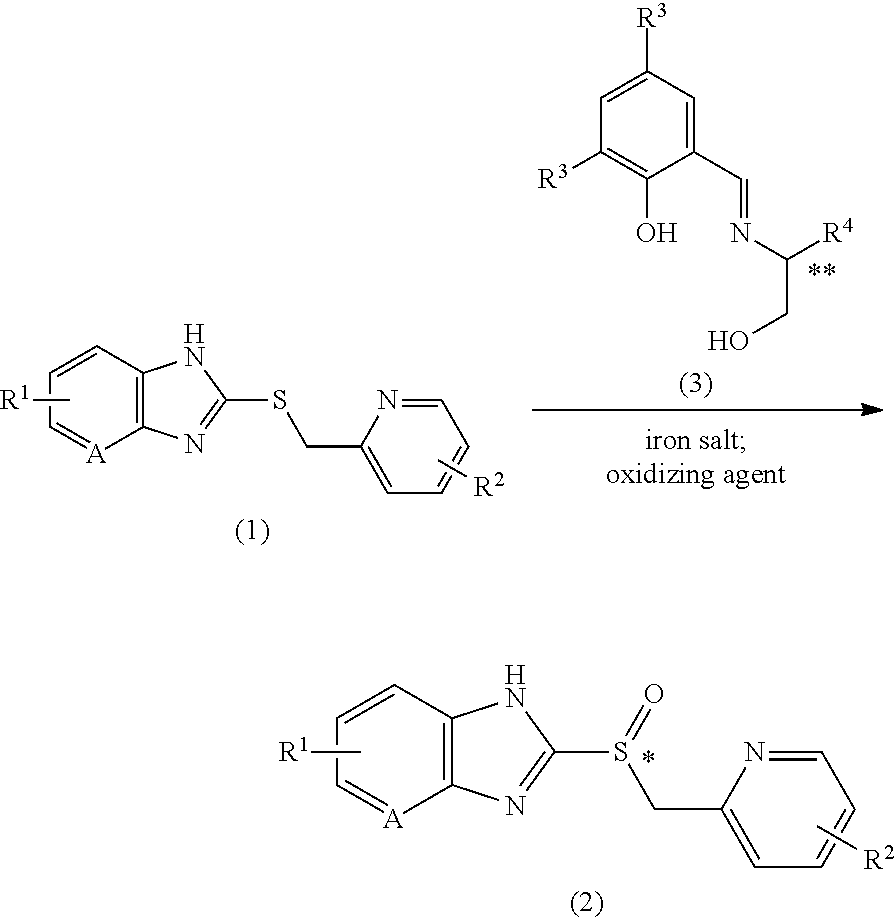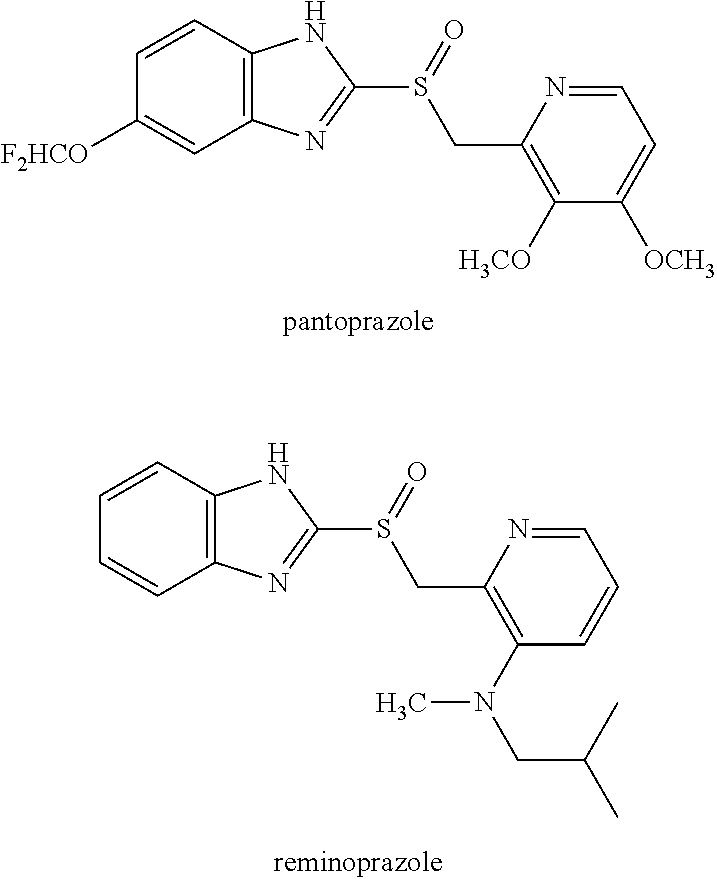Method for producing proton pump inhibitor compound having optical activity
a proton pump inhibitor and compound technology, applied in the direction of organic compounds/hydrides/coordination complexes catalysts, physical/chemical process catalysts, iron organic compounds, etc., can solve the problems of inability to reproduce asymmetric oxidation reaction using titanium catalysts, multi-steps, and inability to achieve cheap and safe hydrogen peroxide, and high yield and enantioselectivity
- Summary
- Abstract
- Description
- Claims
- Application Information
AI Technical Summary
Benefits of technology
Problems solved by technology
Method used
Image
Examples
example 1
Production of S-Sulfoxide A (Esomeprazole)
[0104]79.3 mg (273 μmol) of S-dichloro chiral ligand and 32.2 mg (91.1 μmol) of iron(III) acetylacetonate were dissolved in 0.6 mL of ethyl acetate at 25° C., and stirred for more than 30 min. To the mixed solution were added 7.8 mg (45.5 μmol) of lithium 4-dimethylaminobenzoate and 0.3 mL of ethyl acetate, and the suspension was stirred for more than 30 min. 0.3 g (911 μmol) of sulfide A and 0.9 mL of ethyl acetate were added and the suspension was stirred for more than 30 min. After the mixture was cooled to −5° C., 186 μL (1.82 mmol) of 30% aqueous hydrogen peroxide solution was added dropwise for 2 min or more. After 4.5 hours, the reaction mixture was analyzed under HPLC analysis condition 1.
sulfoxide A 88%; sulfone A 11%; sulfide A 0%
98% ee
examples 2 to 8
Investigation of Reaction Solvent
[0105]Asymmetric oxidation reaction was performed in the same manner as in Example 1 except for using each reaction solvent shown in Table 2 instead of ethyl acetate. The results of the reaction mixture analysis under HPLC analysis condition 1 at the reaction time in Table 2, are shown in Table 2.
TABLE 2ReationReaction solventtimeSulfoxide ASulfone ASulfide A% eeExample 1Ethyl acetate 4.5 hr8811098Example 2Methylene chloride 3 hr7781590Example 3Methanol20.5 hr8114890Example 4Ethanol20.5 hr80171791Example 5Acetonitrile20.5 hr7920192Example 6Toluene / Methanol (1:1 (v / v))20.5 hr7913997Example 7Methyl isobutyl ketone 3.5 hr7272191Example 8t-butyl methyl ether 4.5 hr5493692
[0106]Since reaction rate varied depending on the reaction solvent, the analysis time of the reaction mixture was changed. As can be seen from the above results, all reaction solvents gave generally good enantioselectivity. Especially, ethyl acetate and toluene / methanol showed extremely...
examples 9 to 12
Investigation of Reaction Temperature
[0107]Asymmetric oxidation reaction was performed at the reaction temperature to the temperature shown in Table 3, in the same manner as in Example 2 except for using 4-dimethylaminobenzoic acid instead of lithium 4-dimethylaminobenzoate. The results of the reaction mixture analysis under HPLC analysis condition 1 at the reaction time in Table 3, are shown in Table 3.
TABLE 3ReactionReactionContent (%)temperaturetimeSulfoxide ASulfone ASulfide A% eeExample 9−9° C.4.5 hr7814594Example 10−5° C.3.5 hr7615990Example 11 5° C.2.5 hr7327195Example 1215° C.1.5 hr7619682
[0108]Since reaction rate varied depending on the reaction temperature, the analysis time of the reaction mixture was changed accordingly. As can be seen from the above results, good enantioselectivity was obtained, and selectivity of 90% or more was observed at 5° C. or less.
PUM
| Property | Measurement | Unit |
|---|---|---|
| temperature | aaaaa | aaaaa |
| temperature | aaaaa | aaaaa |
| temperature | aaaaa | aaaaa |
Abstract
Description
Claims
Application Information
 Login to View More
Login to View More - R&D
- Intellectual Property
- Life Sciences
- Materials
- Tech Scout
- Unparalleled Data Quality
- Higher Quality Content
- 60% Fewer Hallucinations
Browse by: Latest US Patents, China's latest patents, Technical Efficacy Thesaurus, Application Domain, Technology Topic, Popular Technical Reports.
© 2025 PatSnap. All rights reserved.Legal|Privacy policy|Modern Slavery Act Transparency Statement|Sitemap|About US| Contact US: help@patsnap.com



